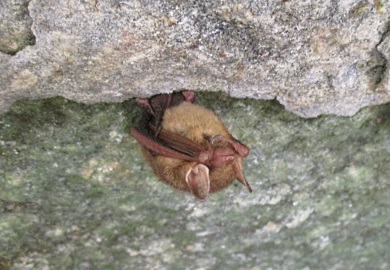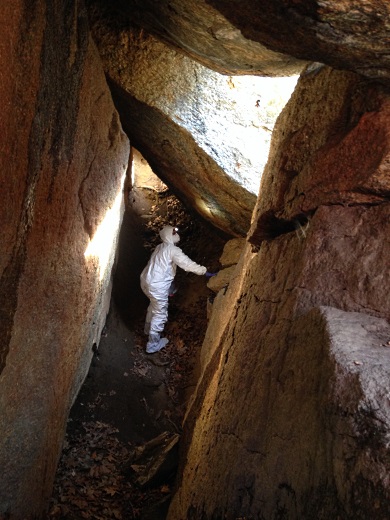DNR News** Archived Article - please check for current information. **
Fungus that causes White-nose syndrome found in three new South Carolina counties so far this yearMarch 28, 2017
The fungus that causes the devastating bat disease white-nose syndrome (WNS) is now present in three new counties in the state: Greenville, Union and Lancaster.

Tri-colored bats are among the most susceptible of South Carolina bat species to white-nose syndrome (WNS). The fungus that causes the devastating bat disease WNS is now present in three new counties in the state: Greenville, Union and Lancaster. (SCDNR photos by Jennifer Kindel)
The South Carolina Department of Natural Resources (SCDNR) recently received confirmation from the National Wildlife Health Center that the fungus was present on bats in each of these counties. This doubles the previous number of counties known to have the fungus in South Carolina. Previously known counties Oconee, Pickens and Richland not only harbor the fungus, but signs of WNS have also been seen in bats there.
Jennifer Kindel, SCDNR wildlife biologist and WNS specialist, said she wasn’t surprised. “We suspect the fungus that causes WNS may be present in many Upstate counties, but the results are still discouraging,” she said. “At the same time, it’s important we fill in those gaps and understand exactly where and how quickly this disease is spreading across South Carolina.
“The silver lining this year is that we didn’t see clinical signs of the disease on any of the 18 tri-colored bats we observed during March, even though the fungus that causes WNS was detected on at least three of those bats,” said Kindel. WNS testing is conducted in March when fungus growth has most likely been established. "So if bats aren’t visibly suffering from the disease right now, these individuals may survive until they wake from hibernation in the coming weeks,” she said.

SCDNR wildlife biologist Jennifer Kindel surveys a bat roosting area in WNS decontamination gear.
Unfortunately, winter surveys conducted earlier in the season continue to show declining hibernating bat populations. In major Upstate hibernacula (places where bats hibernate), tri-colored bat populations have declined at a rate of about 50 percent per year. However, a very small number of banded tri-colored bats have been reported to return to one of these sites, suggesting not every bat exposed to the fungus may be dying from WNS.
Small numbers of bats in other states are also showing signs of resistance or adaptation to the disease. But because bats have very low reproductive rates, recovery from these losses amidst other major threats such as habitat loss may either take a long time or never happen. With still no cure or feasible treatment for WNS, formerly common bats are becoming rare, and some rare bat species may be lost completely.
Tri-colored bats are the first to arrive and the last to leave a hibernaculum, so they have a long exposure time to the cold-loving fungus. Other susceptible hibernating bat species in South Carolina include big brown bats, little brown bats, Eastern small-footed bats, Northern long-eared bats, Southeastern bats and Rafinesque’s big-eared bats. So far in South Carolina, WNS has only been confirmed in tri-colored and Eastern small-footed bats. Elsewhere, the fungus has been found on Southeastern bat and Rafinesque’s big-eared bats, but it remains to be seen if these species will be affected by the disease.
WNS results for three more sites in Abbeville, Cherokee and Laurens counties are still pending. So far this year, WNS has been confirmed in Nebraska, and the fungus that causes WNS has been detected in Texas. WNS in now confirmed in 30 states and five Canadian provinces, and the fungus that causes WNS has been detected in three additional states: Oklahoma, Mississippi and Texas.
| Area | Personnel | Number |
|---|---|---|
| Coastal, Midlands | David Lucas | 843-610-0096 |
| Marine | Erin Weeks | 843-953-9845 |
| Upstate, Midlands | Greg Lucas | 864-380-5201 |
After Hours Radio Room - 803-955-4000
